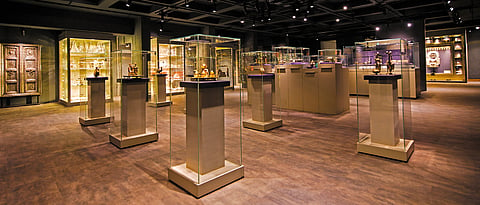
- Destinations
- Experiences
- Stay
- What's new
- Celebrating People
- Responsible Tourism
- CampaignsCampaigns
- Subscribe
- Buy Now

Wandering through the hushed confines of the newly-opened Amrapali Museum in Jaipur, I find myself transfixed at how Indian jewellery has so deeply imbibed the cultural complexities of each region. This geographic diversity lends itself to a rich tradition of ornamentation. At once a celebration of the human form and its timeless linkages with cosmic forces, the glorious pieces on display here are a vivid reminder of how the art of ornamentation is an integral part of ordinary life.
Oppi Untracht, the Finnish author of Traditional Jewelry of India, in his long years of research in the Indian subcontinent, observed that as social hierarchies evolved, particular forms of jewellery, especially those made of valuable metals, became a means of differentiating social status. Design vocabulary varies from state to state, community to community, though the most extensive use of symbols in jewellery is evident in rural and tribal societies. Across the country, artisans have inventively used raw materials at hand and fashioned them with ancient processes, thus reflecting the evolution of society right from prehistoric times.
On display at the museum is a stunning variety of chains, pendants, amulets, head and hair ornaments, earpieces, torso and shoulder ornaments, belts and buckles, armlets, wristlets and cuff bracelets, bangles and bracelets, rings and toe rings, and anklets, sourced from the far reaches of the Indian subcontinent by Rajiv Arora and Rajesh Ajmera, founders of the luxury brand Amrapali Jewels, over 50-odd years.
My wanderings here remind me of the depth and range of Indias abiding love affair with the art and craft of jewellery design and ornamentation, a love that appears to blur borders. Stopping by at a particularly stunning piece from Gujarat, I notice how the physical boundaries between Rajasthan and Gujarat vanish as one encounters numerous similarities between the jewellery of the two regions. Yet, the crafters have dipped into their respective indigenous traditions and resources to create a sumptuous repertoire of jewels.
Guided personally around the showpieces by Rajiv and Rajesh, novices have much to learn here. For example, though we have few samples from ancient times today, there is enough evidence of the superb design quality and technical skill prevalent in the humble karkhanas and royal ateliers of the past. Various regions are recognised for the birth and development of Indias jewellery. Jaipur, for example, along with Varanasi and Lucknow, was the centre of the finest minakari (enamel) work. I encounter delectable mina work on silver and gold pieces on display. The kundan items are a reminder of the exquisite work of artisans in the karkhanas of Bikaner, Punjab and Delhi. The embellishment of kundan reached its zenith under the Mughals, who adorned the reverse side of kundan pieces with mina work, giving the wearer a more luxurious ornament. Showcased in a set of beautiful vases and ittradan from Pratapgarh is the cameo-like beauty of thewa (pierced gold work over transparent glass). In preponderance are elaborate pieces from the south, featuring the Mesopotamian-style granulation technique.
Silver holds a special place in the saga of Indian jewellery, depicted wonderfully in tribal regions. The range of traditional tribal and rural jewellery, with their indigenous symbolism, design and craftsmanship, has been a dynamic feature of Indias tradition. For centuries, it has been the mainstay of ornamentation of rural women, as an indicator of their wealth and social status, and a safe and easily disposable currency to tide over rainy days.
Though its inspirations have been limitless, often shaped by cross-cultural interpretations, it isnt surprising that Indian jewellery craft has remained rooted in tradition.
Amrapali Museum, K-14/B, Ashok Marg, C-Scheme, Jaipur, 0141-5191100, info@amrapalimuseum.com amrapalimuseum.com, amrapalijewels.com
